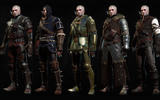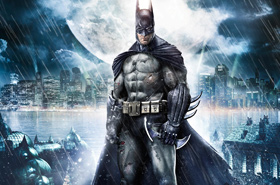From Wikipedia, the free encyclopedia Mechwarrior 4: Mercenaries
Developer(s) FASA Studio
Publisher(s) Microsoft Game Studios / Studio MekTek Inc.[1]
Engine Mechwarrior 4
Version 3.0
Platform(s) Microsoft Windows
Release date(s) November 7, 2002 (US)
November 15, 2002 (EU)
April 30, 2010 (Free, on MekTek.net)
Genre(s) Vehicle simulation game
Mode(s) Single player and Multiplayer
Rating(s) ELSPA: 11+
ESRB: Teen
OFLC: Mature
Media/distribution 2 CD-ROMs
Free Download
System requirements
700 MHz CPU
128 MB RAM
16 MB video card RAM
8X CD-ROM drive
DirectX 8.1
1.0 GB available hard disk space
Windows 98, Windows 2000 or Windows XP; Windows Vista works but is not supported
Mechwarrior 4: Mercenaries is a vehicle simulation video game for the PC released in 2002. It is a standalone expansion of Mechwarrior 4, based on the Battletech Mechwarrior game universe. It was announced on July 9, 2009 that Mechwarrior 4 Mercenaries and the Clan and Inner Sphere expansions will be re-released for free.[2][3][4][5] As of April 22, 2010 the free release of MechWarrior 4 has been cleared by Microsoft.[6]
On April 30, 2010, MechWarrior 4 Mercenaries was released to the general public by MekTek as a free download.[7][8] However due to the massive influx of 100,000 downloads and web site accesses, MekTek.net and related services crashed.[9][10]Contents [hide]
1 Plot
2 Gameplay
3 Features
4 References
5 External links
[edit]
Plot
In the game, the player takes the role of Spectre, a male mercenary BattleMech pilot travelling inside the fictional interstellar region of the Battletech universe called the Inner Sphere during the FedCom Civil War (specifically during the time period from January 1, 3066 to late July 3067). The player makes a living earning cash and useful salvage from completing mission contracts for various factions. With these resources, the player can purchase new weapons and BattleMechs, pay for 'Mech repairs, and hire additional MechWarriors for his or her company.
The player has some control over which missions to accept and in what order. In addition, how each mission is performed has an impact on the timeline. For example, killing civilians and neutral targets results in infamy points, which in high numbers can limit the player to brutal and "unethical" missions. Competing in the various Solaris tournaments (a Gladiator-styled combat arena sport) can boost the player's reputation and increase the likelihood of gaining various mission contracts. Also, the player must choose how to balance his or her allegiance to the different sides of the war (Steiner vs. Davion). This is important as allegiance will eventually affect available contracts and even influence the ending of the game.
In general, Spectre's company walks a fine line between the two factions. During the course of gameplay, several characters, including the tactical officer, reveal backstory about the events leading up to their work as a mercenary, and these events often recount the fighting preceding and during the Clan invasion. In addition, depending on the sponsor regiment, the player gets additional history and background on the "current events" of the unit during the course of the game.
Depending on how the player handled allegiance between House Steiner and House Davion, the player would end up with one of three mission paths, each with their own ending. All of them are interspersed with a small epilogue that hints at the Word of Blake Jihad, the opening stages of which began a few months after the events of the game.
Davion Ending: The player ends up assisting Peter Steiner-Davion in defeating the Lyran loyalists. The final mission sees Spectre taking part in the final assault on the Tharkad palace where Nondi Steiner awaits with her bodyguard lance. The backdrop of this ending is canonical.
Steiner Ending: By siding with Steiner, Spectre must assist an agent from the Rabid Foxes special operations unit in obtaining information on Katherine "Katrina" Steiner-Davion's whereabouts. Ultimately, Spectre must deliver this information to Khan Vlad of Clan Wolf. Doing this requires Spectre to undergo a Trial of Position where he must defeat five consecutive Clan Mechwarriors in the planet Carse. This ending has partial canonity as Katherine was indeed handed over to Vlad in exchange for his promise not to attack the Inner Sphere.
Rogue Ending: This ending is actually an offshoot of the Steiner ending. Prior to the final mission, Spectre's tactical officer, Castle, pleads the case for abandoning Katrina Steiner and the losing side of the war. On her recommendation, an alternative opens up. Instead of undergoing the Trial of Position, Spectre elects to take a contract on New Canton to defend a base under attack by the Capellan Confederation. Success results in Spectre's unit taking the base for themselves.
[edit]
Gameplay
Mechwarrior 4: Mercenaries is first-person mecha simulation game, with the player piloting a Mech in each mission. Mechs are armored and fitted with various projectile and energy weapons, and engage in combat with other Mechs as well as traditional military vehicles such as tanks and helicopters, and occasional weapon emplacements. During combat, a Mech's weapons and critical components can be damaged, and it is even possible for entire limbs to be blown off a Mech.
Since the player is in charge of a mercenary unit, he or she has limited control over mission selection, and is paid based on mission success. Some missions have bonus objectives which will reward the player with additional money if completed. Money can be used to hire new squad mates and purchase vehicles, weapons, and equipment, as well as repair damage to the player's current Mechs.
Mech customization is a major aspect of gameplay. The player has significant control over the configuration of each of his or her Mechs, from the type and amount of armor used to various internal components, and all of the Mech's weaponry and ammunition. In the campaign, additional parts, weapons, and ammunition are acquired through the missions, from captured supplies and salvaged enemy Mechs, and the player can purchase additional Mechs, weaponry, and equipment from the market.
In the campaign, the player controls up to seven squadmates, with the ability to issue basic orders such as attack and move.
The Arena matches are a unique feature brought back from MechWarrior 2: Mercenaries. In an arena match, the player competes with a variety of enemy Mech pilots in "last-man standing" combat. If all other enemy Mechs are destroyed, the player wins the match and is rewarded money. Many of the opposing pilots have names and backstories, which are revealed by the arena announcer who provides constant real-time commentary on the matches. Arena battles are divided into four weight classes and take place in several different arenas. If the player wins all of the matches in each weight class, he or she advances to the championship round, which is open to all weight classes.
[edit]
Features
For game modes, there is a main campaign, and access to all but four missions (final missions for each ending path and the Solaris Grand Championship) for 'instant action' play. Instant action can be mission-based, or wave-based. Mercenaries also has sophisticated online play options. The single-player game includes 19 different maps.
Servers host up to 24 players and bots at a time. MW4 has a built in chat function. Originally the 'Zonestats' online ranking system recorded the victories and other statistics of other players, but it is now defunct. MekTek Studios currently provides and manages a replacement for 'Zonestats' called 'MekMatch.' 'MekMatch' is included with a free release available for download.
While the game can be played strictly as single player game either in the campaign or instant action mode, the vast majority of the gameplay is done in the multiplayer online mode. Several hundred maps and missions are available for download. Online action play is most entertaining as it involves both human players and robot mechs or bots that play amongst human players and fill out a game. All multiplayer games include a real time chat screen allowing players to speak either only to teammates or to all in the game. These dialogues can be intense and enjoyable as well as abused by players. The game continues for set periods of time and is offered in a number of game types including Battle, Mission, TeamBattle, etc. These play types all require differing skills and maps sometime drive the mechs selected, weapons type and armor layouts. Games can also be played in Heat or Non-Heat modes that activate a cooling requirement for the individuals mech design.[11]
Таблица | |
колонка 1 | колонка 2 |
Таблица |
колонка 1 | колонка 2 |




















